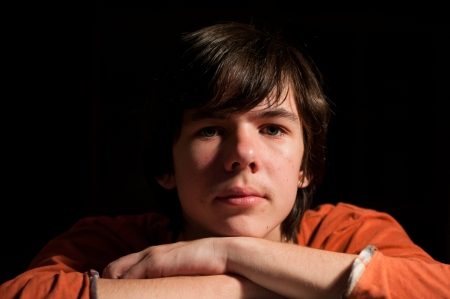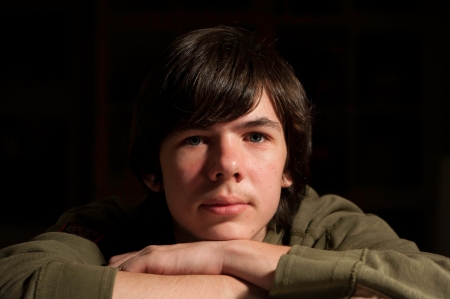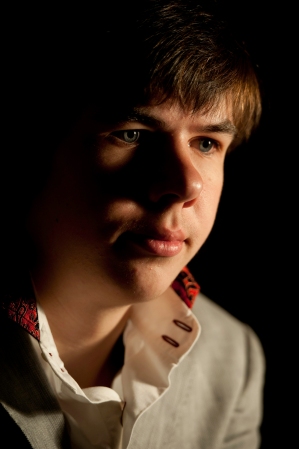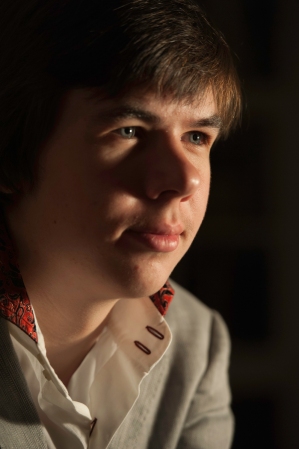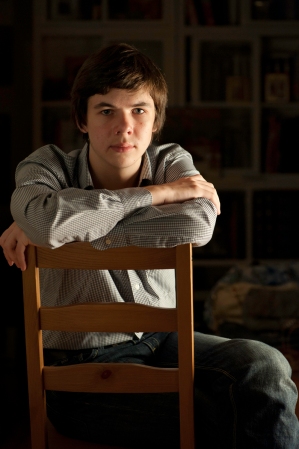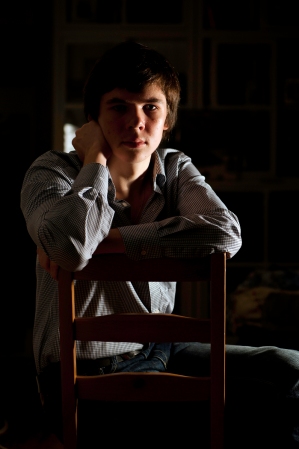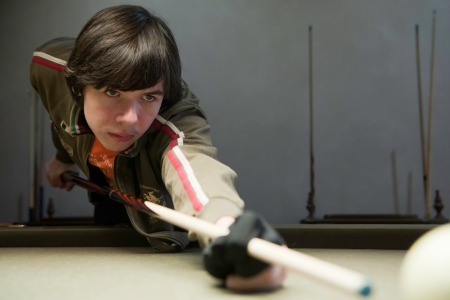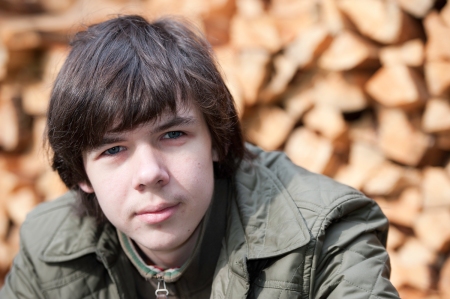Assignment 1. A portrait.
I have chosen Dan to be the model for my first assignment in this course.
Most photographs in this assignment are new ones, however, I do use here two portraits from my exercises as well. There are two reasons for that: first – I consider them successful, second – the new photographs are done in a different style and it is just interesting to compare them from this point.
Working on this project I have looked through quite a number of various portraits and discovered for myself one photographer, who’s approach I found very special – Yousuf Karsh. His models kind of show through darkness on the photographs. They are totally detached of surroundings and appear on their own, without any context or story. They and only they occupy our attention, being open to us and enigmatic at the same time.
I have decided to work in this style and then compare my new works with the older ones.
The first Karsh-inspired portrait that I took was the one below:
I have chosen a lighting scheme called “Rembrandt” and generally I liked the result. This is a very calm and straight portrait. Dan’s direct look into the lens creates much of involvement; stance of his face is open and relaxed. His pose is very stable and does not show any tension here. He is wearing something quite unofficial here and it makes the portrait very homely. By the way, I have noticed here that explanatory role of the background is now shifted to the model’s garments.
Still, I have not been quite sure about one issue with this photograph. There is no light in Dan’s eyes. Shooting a head and shoulders portrait I have not thought it was so important, although I am quite aware that the rule of thumb is to have the light in the eyes. I have decided to re-shoot this portrait after all:
I can say now that the rule is right. Head and shoulders or not, light in the eyes improves portrait without any doubt, making it more vivid and involving.
Notice that Dan looks somewhat moved away from the viewer on this portrait. I think, this is the effect of change of his home shirt for an outdoor sweatshirt. This is just to confirm that model’s garments really do influence mood of a portrait.
For the second portrait in this series I shifted shooting point to the left and below the eye level of my model. Such shift of the shooting point created more dynamics in the new photograph:
Dan’s trendy shirt and jacket bring a scent of festivity into this portrait. However, there is an inner contradiction in it. General composition of this photo is built along the light-and-shadow ascending diagonal from lower left to upper right corner. At the same time, Dan’s look is directed towards lower right part of the photograph. This clash of diagonals creates a specific feeling in this portrait, hints on Dan’s uncertainty or some inner doubt. I like this photograph for its mood and for the simple means by which it is reached:
For comparison, I include another version of this portrait here:
Dan’s look and the light diagonal are in line here and the whole mood of the portrait is different: it is more pointed, more integral; even outline of Dan’s face is smoother here. Not a bad portrait either, but I prefer the first one for deeper feeling that it stirs.
Thinking about improvements that can be done here, may be a smaller diaphragm would be worth trying. It would help making both model’s eyes equally sharp. I have not had this issue with the previous work due to different posing of the model. On the other hand, small diaphragm sharpen his costume and decrease volume in the portrait too. So, it’s a question of finding a right balance.
The next portrait is very minimalistic. I have left as little quantity of light as possible in this frame. The whole portrait consists of two lines: one – outlining Dan’s face and hand and the other – outlining his shoulder:
I find this portrait interesting due to the atmosphere it creates: concentrated and absorbed. It resembles me of attending a scientific presentation or going to a good movie.
I have not expected that my Dan’s face will be very recognizable at this angle, but it really is. May be this recognizability is the reason why I have had to keep focus on the visible eye here. Initially, I have focused on his nose, believing that his eye is barely visible and concentrating on the sharp face outline. Such approach resulted in a strange looking photograph that was not acceptable. Even barely visible, eyes attract a lot of attention anyway. Everything fell in place when I focused on the eye.
Finally, I like the light pattern on Dan’s hand here, the drawing of his fingers with very thin lines.
The following portrait is a sitting figure. I have shot two versions of it and found them so different in style that i considered them as two different portraits.
The first one shows Dan in a casual surrounding, something like at a meeting with friends:
He looks calm and attentive. Soft lighting and huge light reflector on the left help a lot in creation such mood in this photograph.
Let’s compare it with the second portrait to see it better:
Both Dan’s pose and stance are virtually the same here, but the softener has gone from the photo lamp as did the reflector. Immediately the portrait has changed. Shadows become deep and sharp bringing in a lot of rigidity. Now the portrait consists of bright and dark lines, wedges, spots that intersect and end abruptly. Bright spot (reflected photo lamp) on the background outlines Dan’s fist and it fits the mood of this photo perfectly. I think this portrait is so different due to its deeper depth and tension.
The portrait that I am going to show now does not belong to the above series. This is an active portrait in a distinct interior. Comparing to the previous images, it lacks sophisticated, mood-creating lighting, as I have taken it using available light in the billiard room. The mood here appears due to the model’ activity and the interior around and it is very distinct here: focused and concentrated.
Dan is a good player – the idea of this photograph came to my mind during one of our visits to a billiard club. I liked dynamics and static of his preparation for a shot. In practice, the static has appeared much shorter than it looked. So, instead of shooting Dan at a play I had to ask him to pose quite a bit.
All in all, shooting this photograph has taken us about 45 minutes. Most of that time I’ve spent for building a pose that would express my initial impression of Dan’s play: combination of dynamics and static. Triple diagonal of Dan’s gaze, his hand and the cue reinforce one another and create visible tension in this photo. All these lines are pointed at the single object of concentration – the ball in the low right corner. Plain background with a few cues standing emphasizes the very concentrated mood of this portrait.
The final portrait that I am going to take a look at is a quite simple one. It is almost a snapshot of Dan with some timber for a backdrop:
It is that simplicity that I like it for. This portrait is definitely not a masterpiece. Light is too flat here and details of Dan’s face are not depicted too well. Besides, I have used flashlight to light up his eyes and it slightly added to the flatness of the overall lighting.
But still, there is something in the pose and stance here. It perfectly matches the background: friendly and relaxed (it must be something personal, though, I don’t know why I feel that for the pile of timber). This match of the model’s feelings and the surrounding is what I think special here.
That is all for the first assignment. Now I can definitely say I am very glad that I have chosen the People and Place course for my studies. It is a new field for me and I enjoy it to the extent that I have not expected. I do like working with models (at least, with familiar ones for now) and often find them deep, surprising and beautiful.
I hope I will be able to keep this mood in my further projects during this course.
